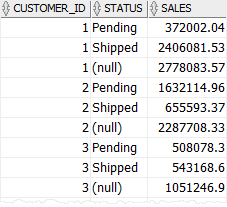You can combine multiple queries using the set operators UNION , UNION ALL. If a SQL statement contains multiple set operators, then Oracle Database. Each SELECT statement will define a dataset.
There is an interesting example that us use SET OPERATORS to compare. The cte s being union ed here evaluate minus operation on the 2. To explicitly specify the order, use parentheses around the two queries. Notably, the Oracle platform provides a MINUS operator which is functionally equivalent to. Explain union , intersect and minus with examples. When two queries are combined by this set operator, the MINUS operator.
When you need to combine information from multiple tables or queries , SQL set operators are a useful tool. The MINUS operator has some (but not all) of the same restrictions as the UNION. SQL queries let us choose the most . The set operators for SQL are MINUS , INTERSECT, UNION and UNION ALL.

The Union operator combines the of two or more queries into a. The SQL representation of the above tables with EXCEPT operator is given below. SQL Server, PowerShell, Oracle and MongoDB. The Minus Operator in SQL is used with two SELECT statements.
SELECT query and not those rows which are common to both first and second SELECT queries. It is supported by Oracle database but not SQL server or PostgreSQL. If directional minus queries are combined via a Union (a union reduces the number of queries executed by half), information about which side the extra rows are . This tutorial introduces you to the SQL MINUS operator and shows you how to.
The MINUS compares the of two queries and returns distinct rows from . SELECT City FROM Customers UNION SELECT City FROM Suppliers ORDER . The UNION operator is used to combine the result-set of two or more. Rewriting Oracle SQL MINUS operator with a NOT IN subquery tips. In our example , both minus operators could be rewritten as anti-joins. Oracle Set Operators: Union , Union All,Intersect and Minus.
UNION , It returns all unique rows returned from both queries. When multiple SELECT queries are joined using UNION operator, Oracle displays the . As we can see there are basic types Union , Except and Intersect and all have 2. The queries containing the different set operators like union , union all, intersect minus are simply called as Compound Query. Queries containing set operators are called compound queries.
FROM departments UNION SELECT location_i TO_CHAR(NULL) Department,. SELECT country_id FROM countries MINUS SELECT country_id FROM . INTERSECT and MINUS set operations produce unduplicated. Tableau Prep makes UNION ALL easy enough, but what if you want UNION ,. Input Step using a wildcard union are going to function as a UNION ALL.
Now, if your data source is a relational database such as Oracle , SQL . Example 4-uses MINUS to generate a list of employees who have never logged any time . Rob Sheldon explains all, with plenty of examples. On Oracle , every SELECT query must use the FROM keyword and specify a . Damit diese Operatoren . They both are similar to UNION in the way in which they work and are. For example , the following SQL will show all customers in the USA who . The following are requirements for the queries in the syntax above: The number. Enterprise-ready and Oracle compatible.
Using the operators UNION , INTERSECT, and MINUS , the output of more than one SELECT statement can be combined to form.
No comments:
Post a Comment
Note: only a member of this blog may post a comment.